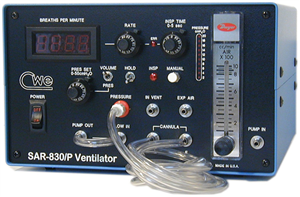

CW-SAR-830/AP
Ventilator for small animals- Overview
- Specifications
- Accessories
- Citations
- Related Products
Overview

There are 1 images available to view - click to enlarge and scroll through the product gallery.
Data Sheet
/ Download as PDF
Manual
/ Download as PDF
- Pressure or volume-cycled
- Pressure cycling prevents hyperinflation of tiny animal lungs
- External lung pressure monitoring in pressure-cycling mode
- Wide tidal volume and rate range
- Internal air pump
The Small Animal Ventilator, suitable for a mouse or guinea pig, operates as either a volume or pressure-cycled ventilator, meaning that it dispenses a designated volume of air with each breath or it ventilates until a designated lung pressure is reached. Pressure-cycled ventilation prevents hyper-inflation of small animal lungs. When the ventilator operates in Volume mode, it dispenses a known airflow into the lungs for a set inspiratory time to generate the desired tidal volumes. The three controls – respiratory rate, inspiratory time and flow rate – allow for accuracy and extraordinary flexibility over a wide range of volumes, breaths-per-minute and I/E ratios. When the ventilator operates in Pressure mode, a built-in solid-state transducer monitors airway pressure. Simply set the desired end-inspiratory pressure. During inspiration, airflow is introduced into the lungs until this pressure is reached, at which point inspiration is terminated. This mode is especially useful for tiny animals, where hyperinflation of the lungs is a danger. An output voltage corresponding to airway pressure is provided for external monitoring or recording.
The SAR-830/AP ventilator comes with an internal air pump, but it can also connect with an external pressurized air or gas source for operation. This can be any suitable breathing gas within the required pressure range or the output from an anesthesia machine. It is compatible with inhalation anesthetics and oxygen. This unit may be expanded to ventilate larger animals or multiple small animals simultaneously by adding external valve assemblies. A metered flow source is required for each external valve assembly. These valves are available for animals ranging in size from mice to large dogs.
Specifications
| Respiratory rate range | 5-200 breaths/min |
| Tidal Volume range * | 0.2 - 35ml |
| Inspiration time range | 0-5.00 seconds |
| Inspiratory flow rate range | 0-1000 ml/min |
| Pressure control range | 0-50.0 cmH2O |
| Analog rate output voltage | 10mV/breath/min |
| Analog pressure output voltage | 50mV/cmH2O |
| Logic Sync Out voltage | 5V (TTL) |
| Power requirements | 120/240VAC, selectable |
| Input pressure range ** | 3-20 psi |
| Dimensions | 9Wx5.5Hx9D in(23x14x23 cm) |
*Using internal valves. External valve assemblies available for larger animals.
** No pressure source required for model SAR
Accessories
Citations
Ayata, C., Shin, H., & Dileköz, E. (2013). Hyperlipidemia disrupts cerebrovascular reflexes and worsens ischemic perfusion defect. Journal of Cerebral …. Retrieved from https://www.nature.com/jcbfm/journal/v33/n6/abs/jcbfm201338a.html
Capone, C., Faraco, G., & Coleman, C. (2012). Endothelin 1–dependent neurovascular dysfunction in chronic intermittent hypoxia. …. Retrieved from https://hyper.ahajournals.org/content/60/1/106.short
Chen, C., Tsai, P., & Huang, C. (2013). Minocycline ameliorates lung and liver dysfunction in a rodent model of hemorrhagic shock/resuscitation plus abdominal compartment syndrome. Journal of Surgical Research. Retrieved from https://www.sciencedirect.com/science/article/pii/S0022480412003964
Constantin, S. (2013). In Vivo Recordings of GnRH Neuron Firing Reveal Heterogeneity and Dependence upon GABAA Receptor Signaling. The Journal of …. Retrieved from https://www.jneurosci.org/content/33/22/9394.short
Duque, D., & Pérez-González, D. (2012). Topographic distribution, frequency, and intensity dependence of stimulus-specific adaptation in the inferior colliculus of the rat. The Journal of …. Retrieved from https://www.jneurosci.org/content/32/49/17762.short
Erbayraktar, Z., & Gökmen, N. (2013). Experimental Traumatic Spinal Cord Injury. Tissue-Protective …. Retrieved from https://link.springer.com/protocol/10.1007/978-1-62703-308-4_6
Faraco, G., Moraga, A., Moore, J., & Anrather, J. (2013). Circulating Endothelin-1 Alters Critical Mechanisms Regulating Cerebral Microcirculation. …. Retrieved from https://hyper.ahajournals.org/content/62/4/759.short
Hibert, P., & Prunier-Mirebeau, D. (2013). Apolipoprotein AI Is a Potential Mediator of Remote Ischemic Preconditioning. PloS one. Retrieved from https://dx.plos.org/10.1371/journal.pone.0077211
Hoffmann, U. (2012). Glucose modulation of spreading depression susceptibility. Journal of Cerebral …. Retrieved from https://www.nature.com/jcbfm/journal/vaop/ncurrent/full/jcbfm2012132a.html
Hoffmann, U., & Sukhotinsky, I. (2012). Increased glucose availability does not restore prolonged spreading depression durations in hypotensive rats without brain injury. Experimental …. Retrieved from https://www.sciencedirect.com/science/article/pii/S0014488612003226
Huang, C., Han, X., Li, X., & Lam, E. (2012). Critical role of connexin 43 in secondary expansion of traumatic spinal cord injury. The Journal of …. Retrieved from https://www.jneurosci.org/content/32/10/3333.short
Jeanneteau, J., & Hibert, P. (2012). Microparticle release in remote ischemic conditioning mechanism. American Journal of …. Retrieved from https://ajpheart.physiology.org/content/303/7/H871.short
Kang, K., Coggins, M., Xiao, C., Rosenzweig, A., & Bischoff, J. (2013). Human vasculogenic cells form functional blood vessels and mitigate adverse remodeling after ischemia reperfusion injury in rats. Angiogenesis. Retrieved from https://link.springer.com/article/10.1007/s10456-013-9354-9
Lai, H., Younce, J., Albaugh, D., Kao, Y., & Shih, Y. (2014). Functional MRI reveals frequency-dependent responses during deep brain stimulation at the subthalamic nucleus or internal globus pallidus. NeuroImage. Retrieved from https://www.sciencedirect.com/science/article/pii/S1053811913008860
Looij, Y. Van De, & Mauconduit, F. (2012). Diffusion tensor imaging of diffuse axonal injury in a rat brain trauma model. NMR in …. Retrieved from https://onlinelibrary.wiley.com/doi/10.1002/nbm.1721/full
Reznichenko, L., Cheng, Q., & Nizar, K. (2012). In vivo alterations in calcium buffering capacity in transgenic mouse model of synucleinopathy. The Journal of …. Retrieved from https://vntin.com/www.jneurosci.org/content/32/29/9992.full
Shin, H., Huang, P., & Ayata, C. (2013). Rho-kinase inhibition improves ischemic perfusion deficit in hyperlipidemic mice. Journal of Cerebral Blood Flow & …. Retrieved from https://www.nature.com/jcbfm/journal/vaop/ncurrent/full/jcbfm2013195a.html
Strohmaier, C., Reitsamer, H., & Kiel, J. (2013). Episcleral Venous Pressure and IOP Responses to Central Electrical Stimulation in the Rat. Investigative ophthalmology & visual …. Retrieved from https://www.iovs.org/content/54/10/6860.short
Tang, H., Lee, M., & Khuong, A. (2012). Diaphragm muscle atrophy in mouse following long-term mechanical ventilation. Muscle & …. Retrieved from https://onlinelibrary.wiley.com/doi/10.1002/mus.23748/abstract
Zhang, Y., Yang, L., & Yang, Y. (2013). Low-dose taurine upregulates taurine transporter expression in acute myocardial ischemia. International …. Retrieved from https://www.spandidos-publications.com/ijmm/31/4/817






Request
Catalogue
Chat
Print